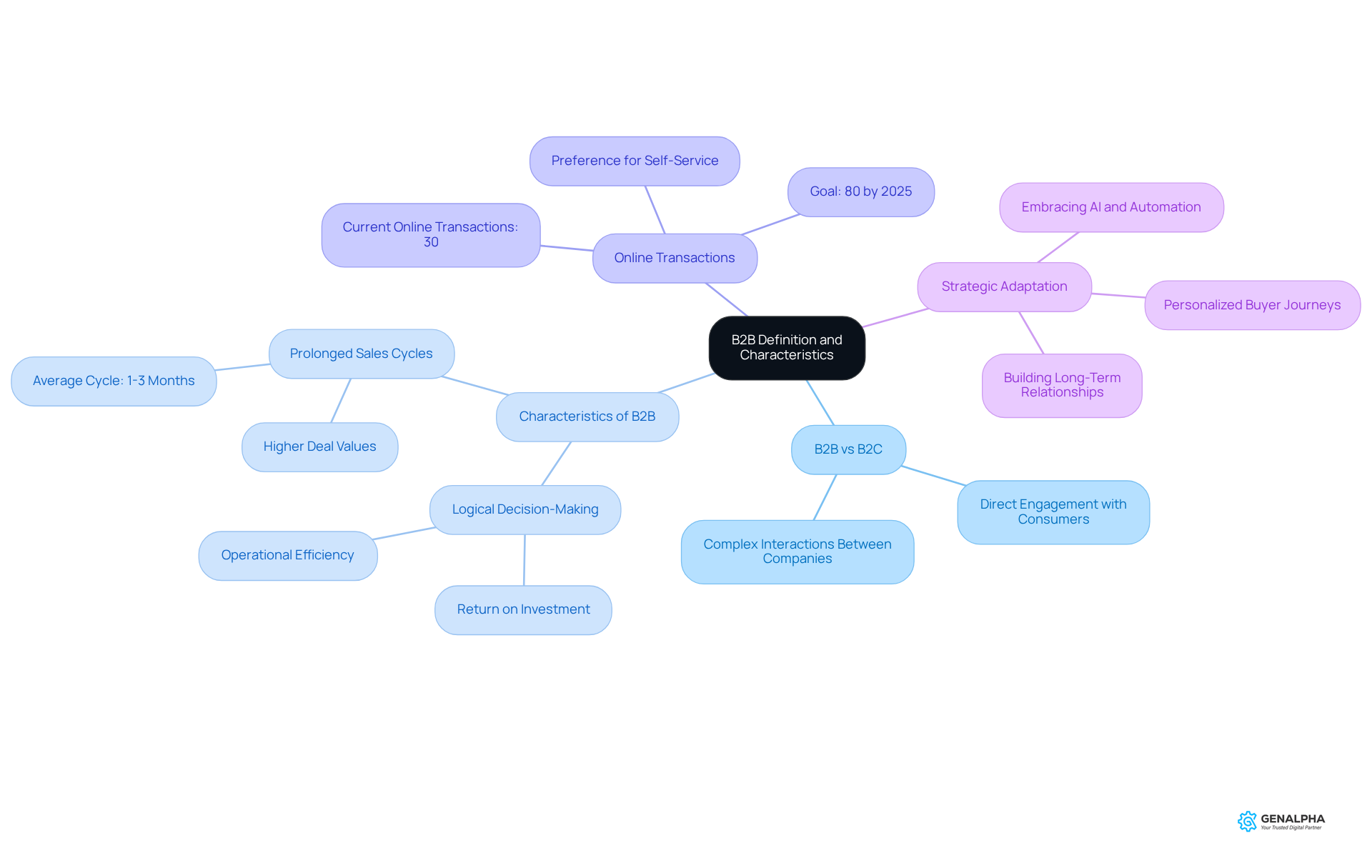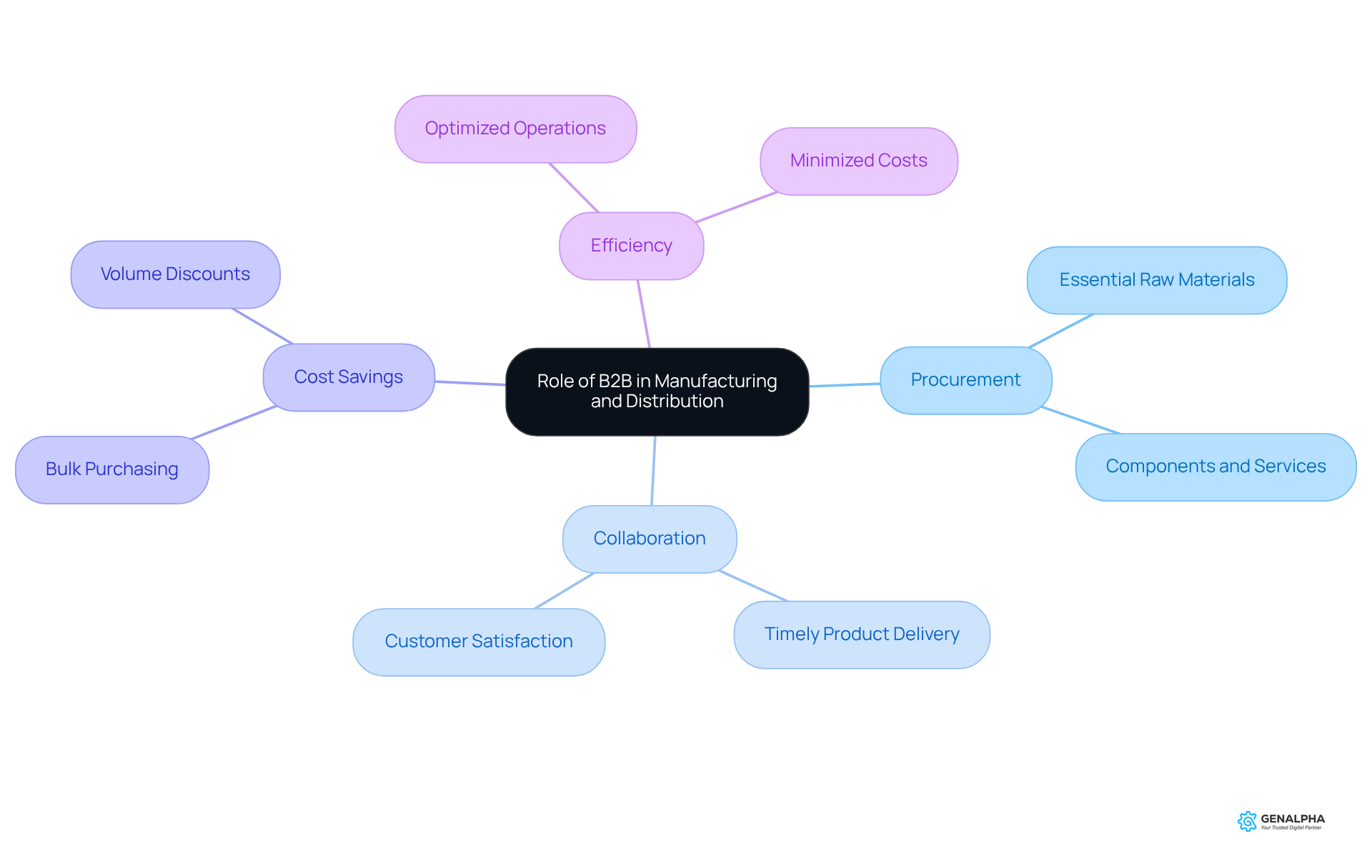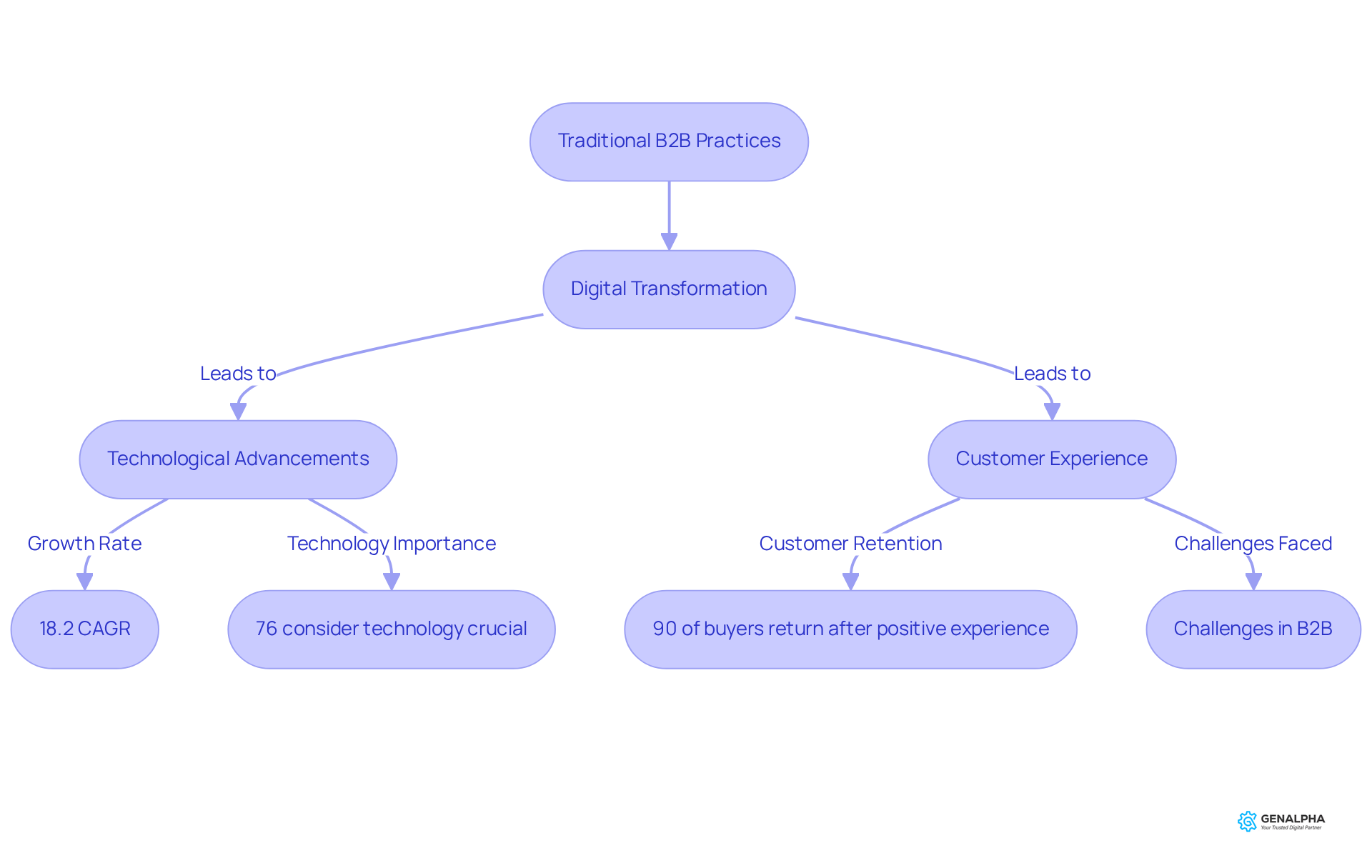Overview
B2B (business-to-business) transactions are vital interactions between companies that play a crucial role in today's marketplace. Characterized by longer sales cycles and logical decision-making processes, these transactions significantly differ from B2C (business-to-consumer) exchanges. The importance of B2B for manufacturers cannot be overstated; these relationships not only enhance operational efficiency but also create increased revenue opportunities. Furthermore, they underscore the necessity for adaptation to digital technologies in a rapidly evolving environment. To thrive, businesses must recognize the transformative power of B2B interactions and leverage these relationships to remain competitive.
Introduction
The intricate web of business-to-business (B2B) exchanges forms the backbone of the global economy, fundamentally shaping the operations of manufacturers and distributors. In today’s competitive landscape, understanding the nuances of B2B transactions is not merely beneficial; it is essential for businesses that aspire to thrive. These interactions drive revenue and foster long-term partnerships.
However, as the industry undergoes rapid digitalization and buyer expectations evolve, manufacturers face a pressing question:
- How can they adapt their strategies to fully leverage the potential of B2B relationships while navigating inherent challenges?
This inquiry is critical for sustaining growth and remaining competitive in an ever-changing market.
Define B2B: Key Concepts and Characteristics
The b2b definition highlights that business-to-business (B2B) exchanges represent a critical facet of the commercial landscape, involving intricate interactions between companies. This contrasts sharply with business-to-consumer (B2C) exchanges, where businesses engage directly with individual consumers. The b2b definition illustrates how companies in the B2B realm are actively involved in selling products or services to other businesses, including wholesalers, producers, and retailers. Notably, B2B dealings are characterized by prolonged commercial cycles, typically spanning from one to three months, and greater average deal values, which are projected to rise significantly by 2025. Unlike the emotional drivers often seen in B2C purchasing decisions, the b2b definition indicates that B2B decisions are predominantly influenced by logical considerations such as return on investment and operational efficiency.
The significance of B2B transactions for producers is underscored by the fact that currently, 30% of all B2B transactions are conducted online, with a goal to increase this to 80% by 2025. This shift highlights the urgent need for producers to to meet evolving consumer expectations, which increasingly favor customized experiences and self-service options. Case studies illustrate this trend: companies leveraging AI and real-time data integration have reported enhanced customer engagement and streamlined operations, ultimately leading to improved revenue outcomes.
Expert opinions emphasize that understanding the complexities outlined in the B2B definition is essential for producers and distributors aiming to refine their marketing strategies. As the competitive landscape evolves, businesses that focus on cultivating long-term relationships and delivering tailored solutions are poised to outperform their rivals. The anticipated growth in typical deal values in B2B sales is driven by the increasing complexity of buyer requirements and the demand for personalized offerings. By embracing these emerging trends and characteristics, producers can strategically position themselves for success in the dynamic marketplace defined by the b2b definition.

Explore the Role of B2B in Manufacturing and Distribution
In the manufacturing and distribution sectors, understanding the B2B definition shows how B2B exchanges serve as the backbone of the supply chain. According to the B2B definition, manufacturers depend on robust B2B relationships to procure essential raw materials, components, and services vital for production. Distributors, in turn, engage in B2B transactions, illustrating the B2B definition, to acquire products from producers, subsequently selling them to retailers or end-users. This intricate web of connections fosters collaboration and enhances efficiency, empowering businesses to and minimize costs.
For instance, a producer may partner with a distributor to ensure timely product delivery, thereby elevating customer satisfaction and loyalty. Moreover, the B2B definition highlights a model that facilitates bulk purchasing, which can yield substantial cost savings for businesses. Leveraging these B2B relationships is not merely advantageous but essential for thriving in today's competitive landscape, as outlined by the B2B definition.

Analyze the Importance of B2B for Manufacturers: Benefits and Challenges
The b2b definition illustrates that B2B connections present significant advantages for producers, including:
- Increased revenue opportunities
- Enhanced customer loyalty
- Improved operational efficiencies
By forging robust collaborations with distributors and suppliers, producers can secure a consistent supply of materials and products, effectively reducing lead times and minimizing inventory costs. However, they face challenges such as:
- Extended sales cycles
- Complex negotiations
- The need for personalized service
These challenges can complicate the B2B definition of interactions. To overcome these obstacles, producers must prioritize and leverage technology to optimize their processes. For example, implementing a digital warranty management system not only boosts customer satisfaction but also simplifies post-sale interactions, thereby enhancing the B2B definition of relationships. As the industry landscape evolves, manufacturers must adapt to these challenges, especially with anticipated shifts in 2025 that will require even greater agility and responsiveness.

Trace the Evolution of B2B: From Traditional to Digital
The b2b definition has significantly shaped the evolution of B2B exchanges through technological advancements. Traditionally, B2B interactions relied heavily on face-to-face meetings, phone calls, and paper-based processes. With the rise of the internet and digital technologies, these interactions have undergone a transformation, which contributes to a clearer b2b definition, allowing businesses to conduct transactions online. E-commerce platforms, such as GenAlpha's Equip360, exemplify this shift by streamlining the purchasing process. They enable manufacturers and distributors to efficiently manage inventory, process orders, and engage with customers. This digital transformation has not only improved operational efficiencies but also greatly enhanced customer experiences by providing real-time access to information and services.
As the B2B landscape continues to evolve, the b2b definition aligns with projections indicating an 18.2% CAGR from 2024 to 2030. Businesses must embrace these changes to remain competitive in the marketplace. The integration of AI and data-driven decision-making is increasingly essential, with over 40% of companies worldwide leveraging to inform their marketing strategies. In this dynamic environment, organizations that adapt to digital technologies will be better positioned to meet the sophisticated demands of today's B2B buyers, which aligns with the b2b definition of providing personalized experiences and seamless interactions. Furthermore, with the B2B commerce market valued at $18.67 trillion in 2023, the b2b definition highlights the undeniable significance of digital transformation.
Additionally, 76% of B2B representatives consider technology crucial for finalizing agreements, which underscores the necessity of adopting technological advancements as part of the b2b definition. Notably, 90% of B2B buyers who enjoy a positive mobile experience are likely to return to the same vendor, emphasizing the critical role of customer experience in the digital landscape. As Steve Jobs wisely remarked, 'most overnight successes took a long time,' reminding us that the journey of digital transformation is ongoing. Lastly, the importance of follow-up in B2B sales cannot be overlooked; persistence in sales efforts is vital for success.

Conclusion
The exploration of B2B—business-to-business transactions—reveals its critical role in shaping the commercial landscape, particularly for manufacturers. In today's competitive environment, understanding the nuances of B2B interactions is essential for businesses aiming to thrive, as these exchanges emphasize logical decision-making and long-term relationships over emotional purchasing drivers.
Key insights from the article highlight the significance of B2B transactions in manufacturing and distribution. The benefits include:
- Increased revenue opportunities
- Enhanced customer loyalty
- Improved operational efficiencies
However, manufacturers also face challenges such as:
- Extended sales cycles
- The necessity for personalized service
The evolution from traditional to digital B2B practices underscores the importance of adapting to technological advancements to meet the sophisticated demands of today’s buyers.
In this dynamic marketplace, embracing the B2B definition is not just advantageous but imperative. Manufacturers are encouraged to leverage technology and cultivate strong relationships to optimize their operations and enhance customer experiences. By doing so, they can position themselves for success in an ever-evolving landscape that increasingly prioritizes personalized interactions and efficient processes. The future of B2B is bright for those willing to adapt and innovate, making it a pivotal area for strategic focus in the manufacturing sector.
Frequently Asked Questions
What does the term B2B stand for?
B2B stands for business-to-business, which refers to exchanges where companies sell products or services to other businesses rather than to individual consumers.
How does B2B differ from B2C?
B2B involves transactions between companies, while B2C (business-to-consumer) involves businesses engaging directly with individual consumers. B2B transactions typically have longer commercial cycles and higher average deal values.
What are the characteristics of B2B transactions?
B2B transactions are characterized by prolonged commercial cycles, typically lasting from one to three months, and are influenced by logical considerations such as return on investment and operational efficiency, rather than emotional drivers.
What percentage of B2B transactions are currently conducted online?
Currently, 30% of all B2B transactions are conducted online, with a goal to increase this to 80% by 2025.
Why is it important for producers to adapt their marketing strategies in B2B?
Producers need to adapt their marketing strategies to meet evolving consumer expectations for customized experiences and self-service options, as the landscape of B2B transactions is changing.
How can companies enhance customer engagement in B2B?
Companies can enhance customer engagement by leveraging AI and real-time data integration, which can lead to streamlined operations and improved revenue outcomes.
What should B2B businesses focus on to succeed in the competitive landscape?
B2B businesses should focus on cultivating long-term relationships and delivering tailored solutions to outperform their rivals in a dynamic marketplace.
What is driving the anticipated growth in typical deal values in B2B sales?
The anticipated growth in typical deal values in B2B sales is driven by the increasing complexity of buyer requirements and the demand for personalized offerings.




